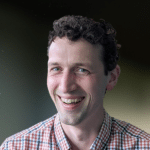What led you to agriculture?
I was originally trained as a hydrogeologist and paleoclimatologist, studying how water and carbon are stored in and cycled through the subsurface. From here, it was a natural transition to work in agriculture, where understanding the interactions among soils, water, crops, and the climate are critically important to the livelihood of the individual growers and to the sustainability of our agricultural system as a whole.
What is your favorite thing about being a crop modeler?
I love the scales involved. We can apply the same models to small areas within a grower’s field; or tens of thousands of fields across the U.S., depending on what we are interested in learning. This presents many challenges, both in terms of engineering and data management, but also in how best to interpret results at these scales. It makes for a really interesting problem to work on.
What is one thing that would surprise people about your field of work in agriculture?
Many growers are scientists in their own right. They run experiments, comparing new seed products, crop management practices, and digital tools in direct head-to-head comparisons in their own fields. It is a constantly evolving industry, and one where individual growers need concrete evidence that a new product will lead to a better outcome on their own farms.
Do you have any papers or articles we can reference?
- Carlson P.E., Noronha A.L., Banner J.L., Jenson J.W., Moore M.W., Partin J.W., Deininger M., Breecker D.O., and Bautista K.K. (2020). Constraining speleothem oxygen isotope disequilibrium driven by rapid CO2 degassing and calcite precipitation: Insights from monitoring and modeling. Submitted to Geochimica et Cosmochimica Acta 284. pp. 222-238.
- Carlson P.E., Banner J.L., Johnson K.R., Casteel R.C., and Breecker D.O. (2019). Carbon Cycling of Subsurface Organic Matter Recorded in Speleothem 14C Records: Maximizing Bomb-Peak Model Fidelity. Geochimica et Cosmochimica Acta 246. 436-449
- Mickler P.J., Carlson P.E., Banner J.L., Breecker D.O., Stern L., and Guilfoyle A. (2019). Quantifying carbon isotope disequilibrium during in-cave evolution of drip water along discrete flow paths. Geochimica et Cosmochimica Acta 244. pp. 182-196.
- Carlson P.E., Miller N.R., Banner J.L., Breecker D.O., and Casteel R.C. (2018). Speleothem chronology with sub-annual resolution in a near-entrance cave setting using oxygen isotopes and trace-elements. Geochimica et Cosmochimica Acta 235. pp. 55-75.
- Bergel S., Carlson P.E., Larson T.E., Wood C.T., Johnson K., Banner J.L., and Breecker D.O. (2017). A subsoil carbon source to cave-air CO2 and speleothem calcite in central Texas. Geochimica et Cosmochimica Acta 217C. pp. 112-127.
Are there events you have spoken at in the past that we can feature?
Public outreach and scientific communication was a big portion of my graduate training. While I’ve given the requisite talks at scientific conferences, the talks I’m most proud of were the ones given to non-technical audiences. I was invited to speak on climate change risk in Texas at a teacher development workshop in Austin. I spoke about the increased risk of drought in central and west Texas, increased flood risk throughout the state, and increased hurricane severity along the Gulf Coast. Coincidentally, the day I gave this presentation was the same day Hurricane Harvey formed, a storm that would make landfall in Houston a week later, becoming the costliest natural disaster in Texas history.
What brought you to CIBO?
I worked in digital agriculture for a few years before CIBO and was looking to move to a company that focused primarily on sustainable and regenerative agriculture. When I read about the SALUS model that serves as the engine behind CIBO products, I was absolutely blown away. The combination of CIBO’s technical capabilities and commitment to a sustainable future meant CIBO was the place for me.
What are your primary responsibilities at CIBO?
I am a crop and soil modeler. I will help to develop new crop models and further develop our models of the interactions between plants and soils.
Peter Carlson is a Crop Modeler at CIBO Technologies, a science-driven software startup. Prior to CIBO, he worked for The Climate Corporation as a data scientist and geospatial engineer. He holds a degree in geological and earth sciences/geosciences from Northwestern University along with a Ph.D. in geological and earth sciences/geosciences from the University of Texas at Austin.
